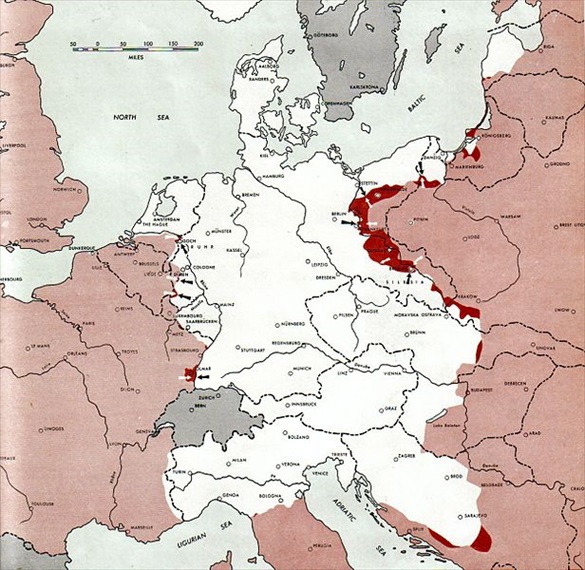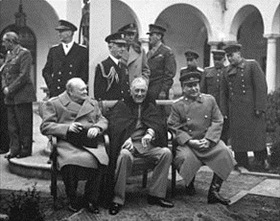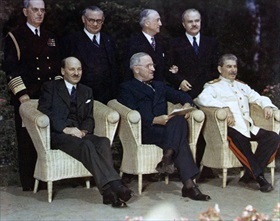SOVIETS AIM TO DOMINATE EASTERN EUROPE
Washington, D.C. • February 2, 1945
The Combined Chiefs of Staff (CCS) was the supreme military staff for the Western Allies during World War II. CCS members were drawn from the British Chiefs of Staff Committee and the American Joint Chiefs of Staff (JCS) and typically met in Washington, D.C. On occasion Soviet military officers attended. Meetings took place between December 24, 1941, when British Prime Minister Winston Churchill and his military advisers paid their first wartime visit to Washington, and July 26, 1945, when the victorious Allied heads of state and their military staffs met in Potsdam outside the former Nazi capital, Berlin. Between those 2 dates the full CCS sometimes met during the great wartime conferences such as the one between Churchill and President Franklin D. Roosevelt in Casablanca, Morocco, in January 1943, when the doctrine of “unconditional surrender” was announced. The two leaders were determined that the Axis powers would be fought to their ultimate defeat, and so preclude Germans from claiming in the future that their country had not been defeated, a claim raised following the November 1918 armistice that ended World War I.
On this date, February 2, 1945, the CCS turned over to the JCS a series of intelligence reports titled “Estimate of Soviet Post-war Capabilities and Intentions.” The assessments concluded that the Soviet Union would seek to control Eastern Europe and influence Central Europe. Already Red Army units occupied Romania, Bulgaria, Hungary, East Prussia, and Poland, and were within 40 miles/64 kilometers of the Nazi capital (see map below). Chillingly, the report predicted that the Soviets would avoid a conflict with their Western partners until at least 1952, but that the Soviets would go to war earlier if they perceived their vital interests in Europe were at stake.
That same day Roosevelt and Churchill discussed the CCS report en route to the Crimean resort of Yalta for the duo’s last summit with Soviet dictator Joseph Stalin. (Looking gaunt and haunt-eyed at Yalta, Roosevelt would die in April.) On the final day of their Yalta Conference, February 11, 1945, the “Big Three” leaders and their military advisers announced agreement on the occupation of Germany and Austria and the division of Poland, which the Red Army was then emptying of Germans. It would be 4½ decades—the length of the Cold War—before the Soviet occupation of Central and Eastern Europe ended peacefully with the collapse of the Soviet Union in 1991.
“Big Three” at 1945 Conferences: Yalta and Potsdam
 |
Above: The military situation at the end of the Yalta Conference in February 1945. The non-colored area represents territory under the control of the German Wehrmacht (armed forces) or the Nazi government. This map is taken from the source “Atlas of the World Battle Fronts in Semimonthly Phases to August 15th 1945: Supplement to the Biennial Report of the Chief of Staff of the United States Army.”
 |  |
Left: “Big Three” and Western military staff at the Yalta Conference in Soviet Crimea, February 4–11, 1945. Photo taken February 9, 1945. Seated are Winston Churchill (left), Franklin D. Roosevelt, and Joseph Stalin. Standing behind them are British Field Marshal Alan Brooke, Admiral of the Fleet Sir Andrew Cunningham, Marshal of the RAF Sir Charles Portal (standing behind Churchill), U.S. Army Chief of Staff George Marshall, and U.S. Fleet Admiral William D. Leahy (standing behind Roosevelt). The heads of state and their military advisers announced agreement on the military occupation of Germany and Austria and the division of a territorially adjusted Poland, which after the war was expanded in the west at Germany’s expense and shrunk in the east to benefit the Soviet Union (the “shrinkage” was Polish territory seized in 1939 by agreement with Adolf Hitler in the Molotov-Ribbentrop Nonaggression Pact).
![]()
Right: “Big Three” with their principal advisers at Part II of the Potsdam Conference, July 28 to August 1, 1945. Seated are British Prime Minister Clement Attlee (left), Churchill’s surprise successor following British elections in early July; U.S. President Harry S. Truman, Roosevelt’s successor in April; and Stalin, resplendent in his new uniform to reflect his status as Marshal of the Soviet Union (equivalent to a five-star general). Some derisively referred to the reshuffled senior statesmen as the “Big Two and a Half” on account of Churchill’s short, bald, unprepossessing replacement. Standing behind the 3 men are Fleet Admiral William D. Leahy, Truman’s Chief of Staff; new British Foreign Minister Ernest Bevin; U.S. Secretary of State James F. Byrnes; and Soviet Foreign Minister Vyacheslav Molotov. The heads of state and their staffs discussed postwar political, economic, and territorial arrangements in Europe, the thorny issue of war reparations, frequently without agreement, and future moves in the war against Japan. The neophyte British team of Attlee and Bevin proved themselves “excellent at the council table.”
Contemporary Newsreel Account of Yalta Conference, February 4–11, 1945
![]()

 History buffs, there is good news! The Daily Chronicles of World War II is now available as an ebook for $4.99 on Amazon.com. Containing a year’s worth of dated entries from this website, the ebook brings the story of this tumultuous era to life in a compelling, authoritative, and succinct manner. Featuring inventive navigation aids, the ebook enables readers to instantly move forward or backward by month and date to different dated entries. Simple and elegant! Click
History buffs, there is good news! The Daily Chronicles of World War II is now available as an ebook for $4.99 on Amazon.com. Containing a year’s worth of dated entries from this website, the ebook brings the story of this tumultuous era to life in a compelling, authoritative, and succinct manner. Featuring inventive navigation aids, the ebook enables readers to instantly move forward or backward by month and date to different dated entries. Simple and elegant! Click 











